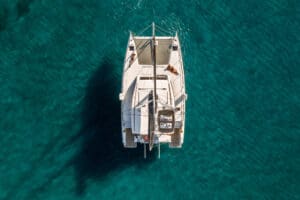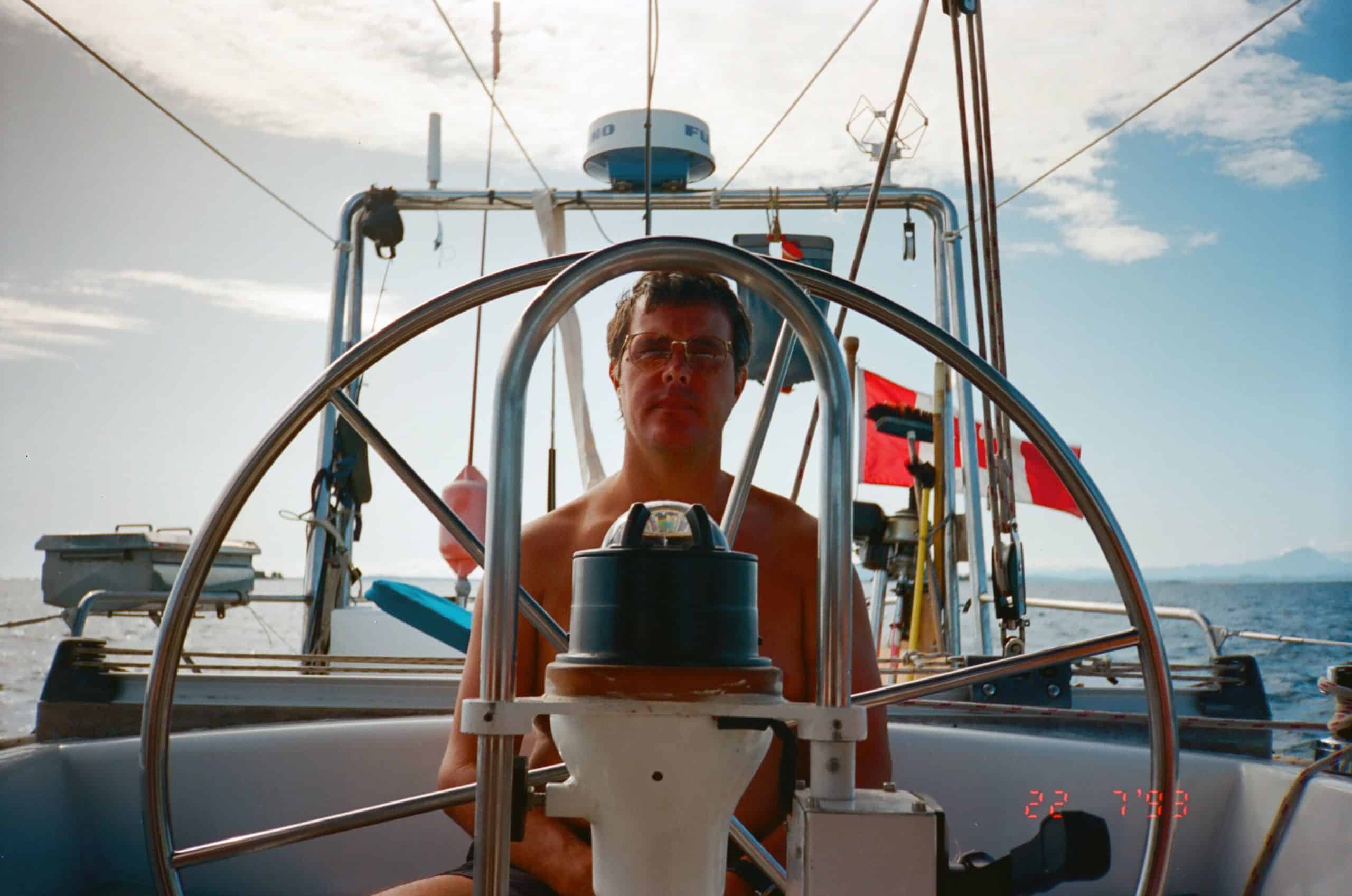 The year was 1992 and our dream was about to start, or was it? We had just “retired” from very busy careers and lives to go cruising on our monohull. Lying around on a sundeck or beach all day sounded nice enough, but how long can one do that before getting bored with doing nothing of consequence and I remember repeating this question from a friend to myself…”What will I do all day?” Well, somehow boredom and “finding something to do” never was a problem. At first, we spent our days “learning” our boat. While Stephen and his partner, Derek, had designed Royal Salute’s electrical, plumbing, and other systems well, the gremlins did do their work dutifully in a maddeningly regular fashion.
The year was 1992 and our dream was about to start, or was it? We had just “retired” from very busy careers and lives to go cruising on our monohull. Lying around on a sundeck or beach all day sounded nice enough, but how long can one do that before getting bored with doing nothing of consequence and I remember repeating this question from a friend to myself…”What will I do all day?” Well, somehow boredom and “finding something to do” never was a problem. At first, we spent our days “learning” our boat. While Stephen and his partner, Derek, had designed Royal Salute’s electrical, plumbing, and other systems well, the gremlins did do their work dutifully in a maddeningly regular fashion.
We started our cruising life off in the Indian Ocean in places like Mozambique, Madagascar, and Zanzibar in the early nineties. While that is probably the most magical time we experienced in our cruising life, it was also the most difficult. Those locales offered few or no resources to fix things on our boat. There was a general lack of spare parts, medical supplies, and most modern conveniences. These guys in Africa apparently kept machines running with some ingenious magic tape and tricks and Stephen learned from them how to ‘make a plan’, pretty quick.
When we desperately needed some critical equipment, we crammed as much information as we could on a page, ordering parts and goodies from South Africa, the land of 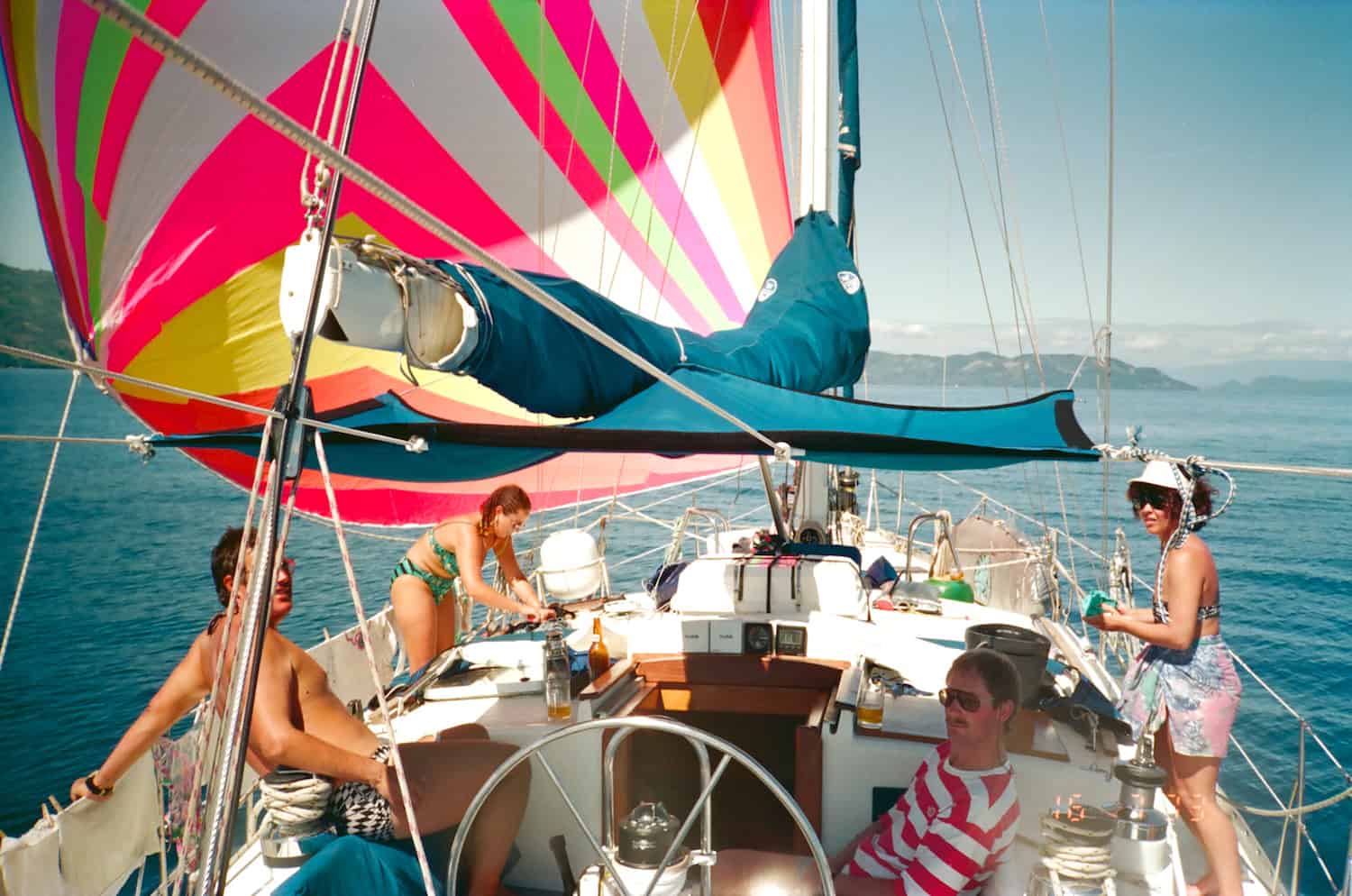 apparent abundance and faxed it to our family or friends, at great expense to us. Communications to other parts of the world were sporadic at best and a one page fax could take forever to go through but it was the cheapest way for us to communicate. So we kept it short and sweet and pleaded with our folks back home to visit us to bring supplies. Shipping an outboard engine (ours had been stolen) to Madagascar cost a fortune. We gladly offered up accommodation on a ‘luxury’ yacht on an exotic island to friends and family for these delivery services. And they obliged, with outboard engine in tow!
apparent abundance and faxed it to our family or friends, at great expense to us. Communications to other parts of the world were sporadic at best and a one page fax could take forever to go through but it was the cheapest way for us to communicate. So we kept it short and sweet and pleaded with our folks back home to visit us to bring supplies. Shipping an outboard engine (ours had been stolen) to Madagascar cost a fortune. We gladly offered up accommodation on a ‘luxury’ yacht on an exotic island to friends and family for these delivery services. And they obliged, with outboard engine in tow!
“Learning” The Boat
 I saw Stephen’s bottom sticking out of a hole in the floorboards more often than not while at anchor. The engine and generator rooms in our monohull were “conveniently”
I saw Stephen’s bottom sticking out of a hole in the floorboards more often than not while at anchor. The engine and generator rooms in our monohull were “conveniently”
situated under the salon floorboards and that was Stephen’s playground. I found myself endlessly passing various tools to “the voice” in the hole and cleaning up the unholy mess after yet another “MacGyver” maneuver in the generator room / hole! Stephen and that generator had a tempestuous relationship at best. No matter what he did, the machine seemed to thumb its nose at him at every turn. (We share some of that marine engine knowledge in this section).
The “chaotic” boat (or what I perceived as being chaotic) upset me to no end. I like order and nothing about greasy tools, upturned floorboards, and smelly bilges is orderly. It never even occurred to me to try to learn what the “voice” was doing down there. I was convinced that this was an evil plot to drive me crazy and I was determined to hate the machines under the floorboards. Not until much later did I accept that life on a sailboat is just not perfect and if you are not prepared to suck it up sometimes, cruising is not for you. They say that with age comes wisdom, but unfortunately, wisdom did not happen fast enough to prevent me from acting abominably stupidly at times.
I now realize just what a genius “the voice” turned out to be. Stephen could eventually diagnose any problem on the boat and fix it in no time, a mean fete considering the limited resources at the time and without our visitors, who acted as couriers for our various spare parts needed to keep the ship in shape, life could have been a lot more difficult. The lesson: Start the learning curve in a cruising ground more accessible and with some resources, it could save you a lot of money and drama.
Boat Toilet Issues (more commonly referred to as the “Head”)
And then there were the endless toilet / head clogging episodes! In the first year of cruising we received many visitors onboard. As we all know, landlubbers and boat toilets just do not gel. The guest head was dismantled to be unclogged more times than I care to remember. We learned eventually that visitors had to be “schooled” in toilet use onboard. That is when Stephen started his ‘one-square-per-person’ routine and voila! Toilet problems vanished! It grossed out many of our female guests but it had the desired effect. See our tips on converting a manual head to an electric head.
 Laundry On A Boat
Laundry On A Boat
Aahhh…laundry indeed! I bought a little contraption in South Africa before we left, called a Sputnik, also called the Laundry Alternative Wonderwash Non-Electric Portable Compact Mini Washing Machine. I proudly put it to service the first time on an island called Juan de Nova in the middle of the Indian Ocean. The instructions were: Fill with water, soap and laundry, turn the handle 20 times to agitate, leave 30 minutes to soak, agitate again, rinse and voila! Magic happened because your laundry should be clean and fresh! Well, not so much.I turned that handle until my arm felt like I had turned it out of its own socket, hoping for better results that I simply never achieved with my Sputnik. I eventually used the thing to store stuff in and later dumped it. It was useless. I ended up washing my laundry by hand or by foot sometimes. It was an endlessly laborious task that was further complicated by the lack of fresh water on board. After months of battling, I figured out the solution:
- wear fewer clothes
- wear clothes several times before laundering
- spot clean stains right away so you can rewear
- air dry yourself in the breeze instead of using heavy towels
- and wait for laundry day on the island when the whole village jumps in to help.
Here are a few tips on cleaning aboard a boat, including laundry.
Learning The Art Of Provisioning On A Boat
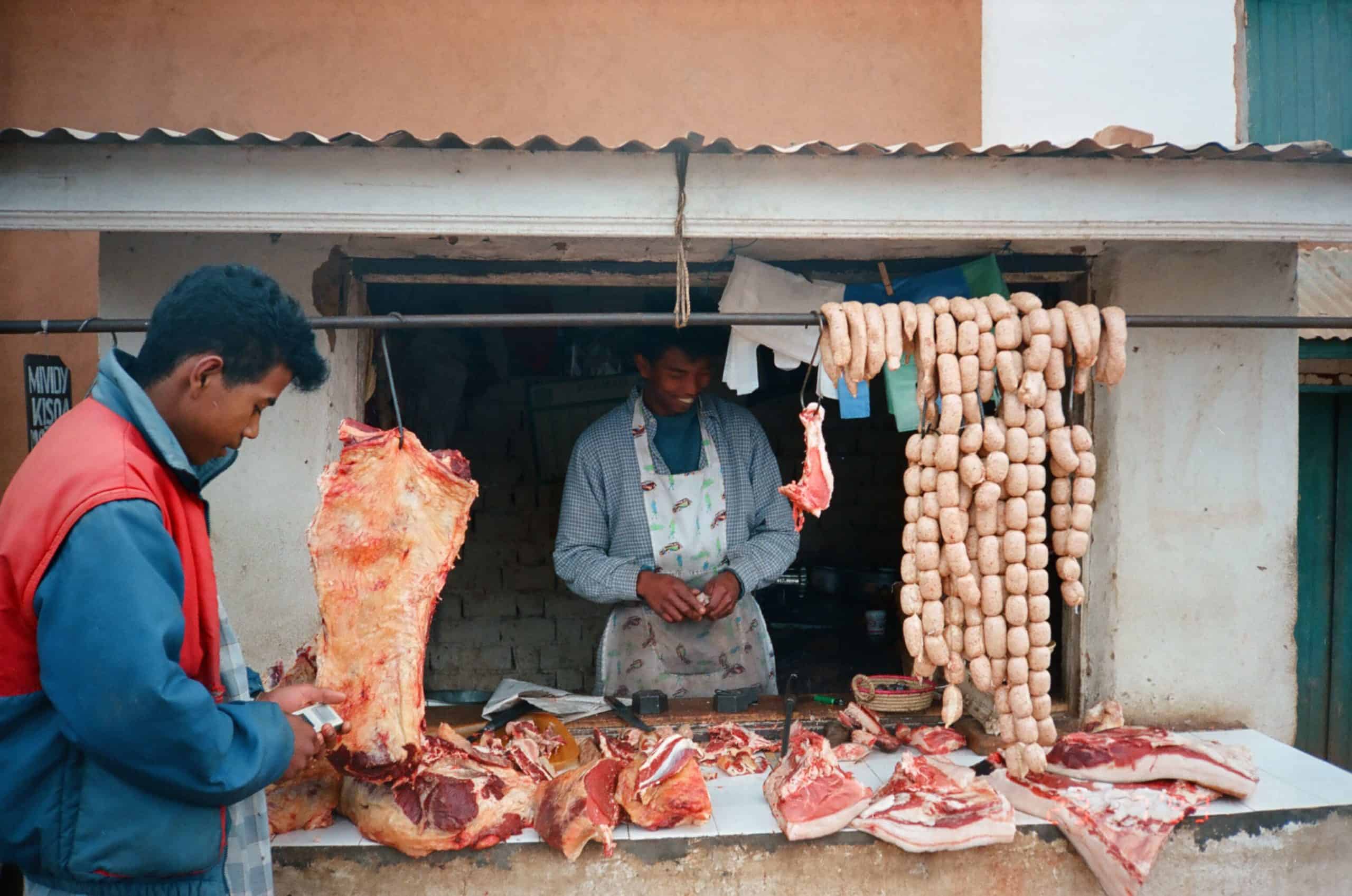 There were no supermarkets with nicely packaged food in Mahajunga, the main coastal town of Madascar, where we re-provisioned our
There were no supermarkets with nicely packaged food in Mahajunga, the main coastal town of Madascar, where we re-provisioned our 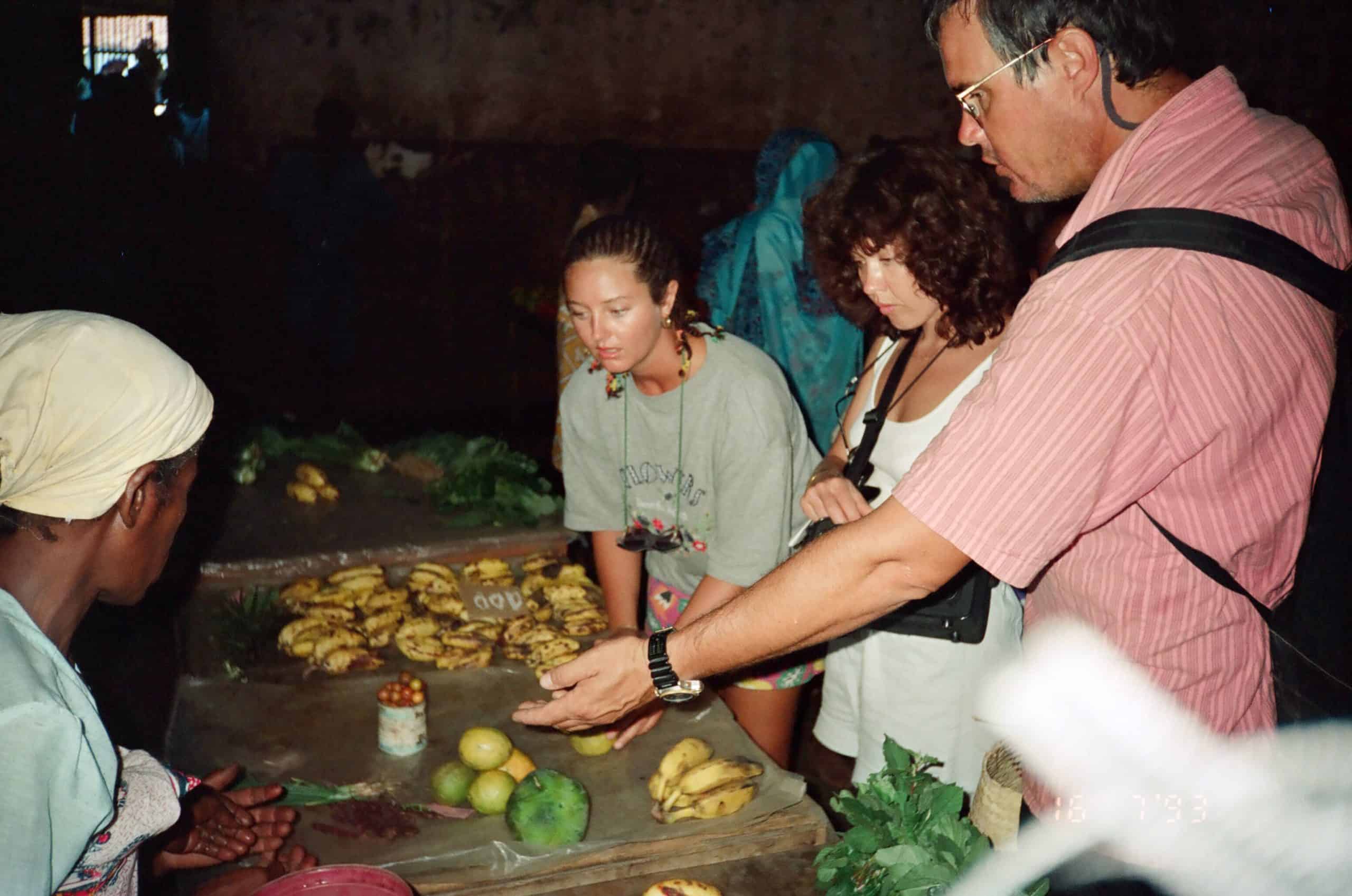 meat supplies for the first time after we left the continent. I had to negotiate the local market at five o’clock in the morning to get some Zebu meat, the local beast of burden. I first had just gotten over the shock of having to forage for food at that time of the morning, when I next had to deal with the blood and guts of the animal at the market.
meat supplies for the first time after we left the continent. I had to negotiate the local market at five o’clock in the morning to get some Zebu meat, the local beast of burden. I first had just gotten over the shock of having to forage for food at that time of the morning, when I next had to deal with the blood and guts of the animal at the market.
Vendors slaughtered the animals very early in the morning and while the fresh blood was still running down the gutters, chunks of meat and carcasses were laid out on slabs of cement for the customer’s viewing. With no refrigeration, the meat goes bad fast in the tropical heat. Local customers knew to quickly pick out a piece of meat and scurry off to cook it. I still had to learn that trick about snatching up a “good” cut and wrapping it quickly before a million flies attacked the meat for their share of the booty!
Picking out a piece of meat from a carcass with the liver still trembling and the blood spattered all over, was a a ghastly task. While trying not to gag, I would quickly wrap my spoils in my own re-used plastic bag (there are no bags on this island) and would swiftly rush back to the boat (as much as one can rush with a 2 HP outboard dinghy engine) with a swarm of flies following behind me. Even the chickens (little scrawny road runners) had to be plucked…really, chicken meat has feathers? I learned the tricks of bartering and shopping at the local markets quickly and became an efficient shopper but what a learning curve!
Dinghy: Essential Equipment On A Cruising Boat
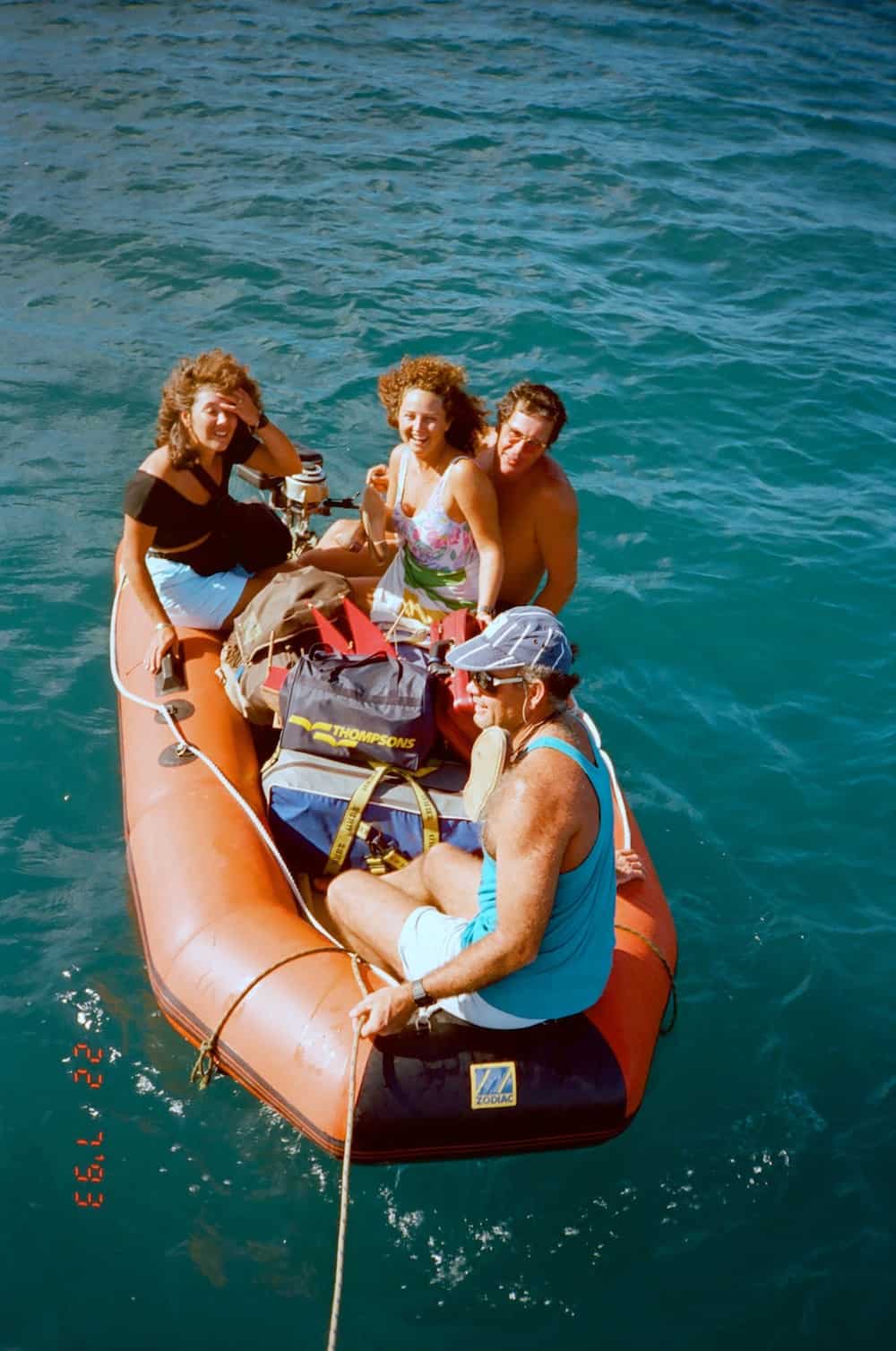 Having had almost no anchoring experience in South Africa (we have no real anchorages to speak of), we believed that the smaller the
Having had almost no anchoring experience in South Africa (we have no real anchorages to speak of), we believed that the smaller the  dinghy and outboard engine, the easier to handle and stow. In theory that was correct, but in practice, it was a big mistake! The dinghy gave us as much, if not more, trouble as the big boat did! Our dinghy was a bright yellow 8ft Robbie Duck with an inflatable floor, fitted with a 2 HP Seagull engine. It basically was a teeny plastic inflatable tub!
dinghy and outboard engine, the easier to handle and stow. In theory that was correct, but in practice, it was a big mistake! The dinghy gave us as much, if not more, trouble as the big boat did! Our dinghy was a bright yellow 8ft Robbie Duck with an inflatable floor, fitted with a 2 HP Seagull engine. It basically was a teeny plastic inflatable tub!
Stephen and I could just barely fit in the dinghy and loaded up with provisions, we just about sunk! We got so wet in our little tub that we looked like two drowning victims by the time we got to the shore or back to the boat. And that was only if we were lucky enough to keep the pontoons properly inflated. The dinghy always had a leak somewhere and it did not take us long to figure out that beaching a plastic inflatable tub on coral islands was simply absurd!
So Stephen, the ultimate optimist, promptly had a pirogue built. It is a canoe made of a hollowed-out tree trunk, fitted with an outrigger. We picked out the log up in the hills of Nosi Comba ourselves and some local tradesmen started wielding their machetes like crazed lunitics, apparently “building a boat”. It took about a month to carve a “boat” out of this humongous piece of wood and it was a work of art! We figured that this “dinghy” should be bullet proof. Well yes, it was, but it was also heavy and it turned out, too long. We simply could not hoist it onto the deck and could therefore not transport it. A month of anticipation and too many precious dollars went down the drain. We donated the pirogue to the local village on the island and had a bright orange Zodiac dinghy “imported by courier”.
The 2HP Seagull engine also did not help our case. It took us a lifetime to get anywhere after a lifetime of trying to get the thing started up. It had no gears, so once it started up, it took off look a bat out of hell, screeching like a deranged animal and behold anyone in its way! Someone once said that the only moving part on a Seagull is the owner trying to start the engine…and so it went.
It took us several tries and much money before we found a dinghy in the Caribbean called a Caribe that could withstand the rigors of cruising life.Update: here is a dinghy we fell in love with and purchase for our new Lagoon 450S.
Be Prepared For Everything!
 One night we partied ashore at a local restaurant with friends and consumed a lot of rum at a local
One night we partied ashore at a local restaurant with friends and consumed a lot of rum at a local
restaurant. Rum was locally made, plentiful and cheap, so we were one happy crew! It was a dark sultry night and after too many hours later and a few too many 150 proof rums, we were ready to go back to the boat which was anchored out off the beach, or so we thought. When we arrived to the spot where the dinghy was anchored in the shallow water that afternoon, there was no water. The dinghy was sitting high and dry! We forgot about the massive tide and between the dinghy and the water, sat a stretch of about 100 meters of razor sharp reef, rocks and stinging nettles.
Our inflatable dinghy had to be carried out to safe water beyond the reef for fear of getting more holes in the pontoons. We were a little tipsy and stumbled across the reef, barefoot in the dark (we did not bring shoes or flashlight) and slashed our feet to ribbons ( or so it felt). Not to mention the hundreds of bits of nettles embedded in our skin, which had to be removed one by one the next day. When we finally made it into the dinghy and motored out to the big boat, it was nowhere to be found in the inky darkness! We were convinced that our boat was stolen or had drifted away when we almost crashed into our equally dark boat. We did not leave an anchor light on! These were classic rookie mistakes. We learned valuable lessons that night:
- check the tides,
- take a flash light,
- take shoes, and always
- leave the anchor light on, even if you go ashore in the day time!
Conclusion
For at least the first two years of sailing, we were busier than we had ever been at home. There was the physical and mental “ballet” necessary to sail and handle the boat, anchoring, navigating, security, food shopping and learning the art of clearing customs in foreign countries in different languages, experiencing new cultures and customs, learning to live on a small budget and on and on. We were fresh from South Africa and that took some adjustment, too. Life was utterly different! So, as you can tell, the “ship” and the “foreignness” of everything at the time kept us busy…we had so much to learn!



